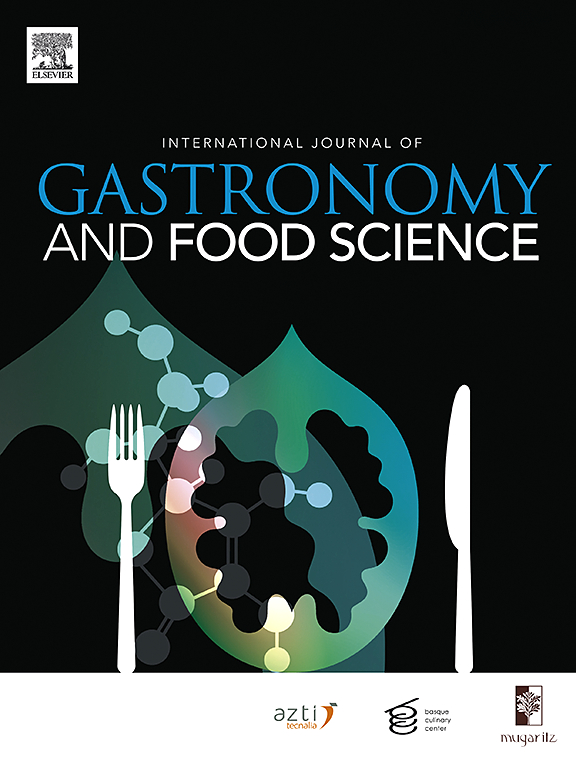Ora-pro-nóbis (Pereskia aculeata) leaves as an alternative ingredient for pesto sauce: chemical, rheological and sensory evaluation
IF 3.6
2区 农林科学
Q2 FOOD SCIENCE & TECHNOLOGY
International Journal of Gastronomy and Food Science
Pub Date : 2025-07-01
DOI:10.1016/j.ijgfs.2025.101240
引用次数: 0
Abstract
Unconventional Food Plants, such as ora-pro-nóbis, have been applied as a potential food ingredients due to their nutritional and sensorial quality, combined with low cost and sustainable characteristics. In this sense, this study aimed to explore the use of ora-pro-nóbis leaves as a substitute for basil leaves in the production of pesto sauce. Five formulations were developed: the traditional version with basil; and formulations with replacement of 25 %, 50 %, 75 % and 100 % replacement of basil leaves by ora-pro-nóbis. These were analyzed for proximate composition, rheological properties, sensory characterization using the Rate-All-That-Apply methodology, directional and global acceptability and purchase intention. The results showed that the different proportions of basil and ora-pro-nóbis did not influence the proximate composition of the formulations. However, increasing the proportion of ora-pro-nóbis leaves resulted in a reduction in the apparent viscosity of the sauces. Replacing basil leaves with ora-pro-nóbis influenced the intensity of perception of the attributes “fresh herb color”, “greenish color”, “rancidity” and “bitter aftertaste”, as well as the consumer acceptability and purchase intention. It is recommended to replace 25 % of basil leaves with ora-pro-nóbis without reducing the magnitude of overall acceptance of the sauce (mean hedonic score of 7.75), as well as the purchase intention (mean categorical score of 4.17), compared to the traditionally accepted and marketed pesto. Therefore, it is concluded that ora-pro-nóbis leaves enable the development of new culinary formulations of pesto sauce, preserving the sensory and nutritional quality of this product category, while also promoting sustainability and reducing costs.
Ora-pro-nóbis (Pereskia aculeata)叶子作为香蒜酱的替代成分:化学,流变学和感官评价
非常规食品植物,如ora-pro-nóbis,由于其营养和感官品质,加上低成本和可持续的特点,已被用作潜在的食品成分。在这个意义上,本研究旨在探索ora-pro-nóbis叶作为罗勒叶的替代品在香蒜沙司的生产中。开发了五种配方:传统版本的罗勒;用ora-pro-nóbis替代25%、50%、75%和100%罗勒叶的配方。分析了这些材料的近似成分、流变特性、使用Rate-All-That-Apply方法的感官表征、定向和全球可接受性以及购买意愿。结果表明,不同比例的罗勒和ora-pro-nóbis不影响配方的近似组成。然而,增加ora-pro-nóbis叶的比例导致酱汁的表观粘度降低。用ora-pro-nóbis代替罗勒叶影响了消费者对“鲜色”、“偏绿”、“酸败”、“苦味”等属性的感知强度,以及消费者的接受度和购买意愿。与传统上接受和销售的香蒜沙司相比,建议用ora-pro-nóbis代替25%的罗勒叶,同时不降低酱料的总体接受程度(平均享乐得分为7.75)和购买意愿(平均分类得分为4.17)。因此,我们得出结论,ora-pro-nóbis叶子有助于开发新的香蒜沙司烹饪配方,保持该产品类别的感官和营养品质,同时促进可持续性和降低成本。
本文章由计算机程序翻译,如有差异,请以英文原文为准。
求助全文
约1分钟内获得全文
求助全文
来源期刊

International Journal of Gastronomy and Food Science
Social Sciences-Cultural Studies
CiteScore
5.30
自引率
10.50%
发文量
170
审稿时长
45 days
期刊介绍:
International Journal of Gastronomy and Food Science is a peer-reviewed journal that explicitly focuses on the interface of food science and gastronomy. Articles focusing only on food science will not be considered. This journal equally encourages both scientists and chefs to publish original scientific papers, review articles and original culinary works. We seek articles with clear evidence of this interaction. From a scientific perspective, this publication aims to become the home for research from the whole community of food science and gastronomy.
IJGFS explores all aspects related to the growing field of the interaction of gastronomy and food science, in areas such as food chemistry, food technology and culinary techniques, food microbiology, genetics, sensory science, neuroscience, psychology, culinary concepts, culinary trends, and gastronomic experience (all the elements that contribute to the appreciation and enjoyment of the meal. Also relevant is research on science-based educational programs in gastronomy, anthropology, gastronomic history and food sociology. All these areas of knowledge are crucial to gastronomy, as they contribute to a better understanding of this broad term and its practical implications for science and society.
 求助内容:
求助内容: 应助结果提醒方式:
应助结果提醒方式:


